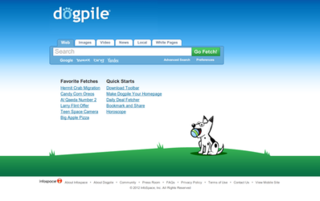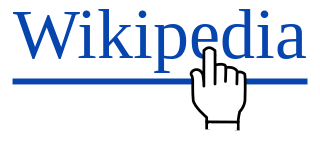Related Research Articles
Meta elements are tags used in HTML and XHTML documents to provide structured metadata about a Web page. They are part of a web page's head section. Multiple Meta elements with different attributes can be used on the same page. Meta elements can be used to specify page description, keywords and any other metadata not provided through the other head elements and attributes.

A Web crawler, sometimes called a spider or spiderbot and often shortened to crawler, is an Internet bot that systematically browses the World Wide Web and that is typically operated by search engines for the purpose of Web indexing.
Spamdexing is the deliberate manipulation of search engine indexes. It involves a number of methods, such as link building and repeating unrelated phrases, to manipulate the relevance or prominence of resources indexed in a manner inconsistent with the purpose of the indexing system.
robots.txt is the filename used for implementing the Robots Exclusion Protocol, a standard used by websites to indicate to visiting web crawlers and other web robots which portions of the website they are allowed to visit.
Search engine optimization (SEO) is the process of improving the quality and quantity of website traffic to a website or a web page from search engines. SEO targets unpaid traffic rather than direct traffic or paid traffic. Unpaid traffic may originate from different kinds of searches, including image search, video search, academic search, news search, and industry-specific vertical search engines.

Googlebot is the web crawler software used by Google that collects documents from the web to build a searchable index for the Google Search engine. This name is actually used to refer to two different types of web crawlers: a desktop crawler and a mobile crawler.
Internet research is the practice of using Internet information, especially free information on the World Wide Web, or Internet-based resources in research.

The deep web, invisible web, or hidden web are parts of the World Wide Web whose contents are not indexed by standard web search-engine programs. This is in contrast to the "surface web", which is accessible to anyone using the Internet. Computer scientist Michael K. Bergman is credited with inventing the term in 2001 as a search-indexing term.

Dogpile is a metasearch engine for information on the World Wide Web that fetches results from Google, Yahoo!, Yandex, Bing, and other popular search engines, including those from audio and video content providers such as Yahoo!.

A metasearch engine is an online information retrieval tool that uses the data of a web search engine to produce its own results. Metasearch engines take input from a user and immediately query search engines for results. Sufficient data is gathered, ranked, and presented to the users.
A backlink is a link from some other website to that web resource. A web resource may be a website, web page, or web directory.
Doorway pages are web pages that are created for the deliberate manipulation of search engine indexes (spamdexing). A doorway page will affect the index of a search engine by inserting results for particular phrases while sending visitors to a different page. Doorway pages that redirect visitors without their knowledge use some form of cloaking. This usually falls under Black Hat SEO.
Findability is the ease with which information contained on a website can be found, both from outside the website and by users already on the website. Although findability has relevance outside the World Wide Web, the term is usually used in that context. Most relevant websites do not come up in the top results because designers and engineers do not cater to the way ranking algorithms work currently. Its importance can be determined from the first law of e-commerce, which states "If the user can’t find the product, the user can’t buy the product." As of December 2014, out of 10.3 billion monthly Google searches by Internet users in the United States, an estimated 78% are made to research products and services online.

The anchor text, link label or link text is the visible, clickable text in an HTML hyperlink. The term "anchor" was used in older versions of the HTML specification for what is currently referred to as the a element, or <a>. The HTML specification does not have a specific term for anchor text, but refers to it as "text that the a element wraps around". In XML terms, the anchor text is the content of the element, provided that the content is text.

A search engine is a software system that finds web pages that match a web search. They search the World Wide Web in a systematic way for particular information specified in a textual web search query. The search results are generally presented in a line of results, often referred to as search engine results pages (SERPs). The information may be a mix of hyperlinks to web pages, images, videos, infographics, articles, and other types of files. Some search engines also mine data available in databases or open directories. Unlike web directories and social bookmarking sites, which are maintained by human editors, search engines also maintain real-time information by running an algorithm on a web crawler. Any internet-based content that cannot be indexed and searched by a web search engine falls under the category of deep web.
Web archiving is the process of collecting portions of the World Wide Web to ensure the information is preserved in an archive for future researchers, historians, and the public. Web archivists typically employ web crawlers for automated capture due to the massive size and amount of information on the Web. The largest web archiving organization based on a bulk crawling approach is the Wayback Machine, which strives to maintain an archive of the entire Web.
Instant indexing is a feature offered by Internet search engines that enables users to submit content for immediate inclusion into the index.
A focused crawler is a web crawler that collects Web pages that satisfy some specific property, by carefully prioritizing the crawl frontier and managing the hyperlink exploration process. Some predicates may be based on simple, deterministic and surface properties. For example, a crawler's mission may be to crawl pages from only the .jp domain. Other predicates may be softer or comparative, e.g., "crawl pages about baseball", or "crawl pages with large PageRank". An important page property pertains to topics, leading to 'topical crawlers'. For example, a topical crawler may be deployed to collect pages about solar power, swine flu, or even more abstract concepts like controversy while minimizing resources spent fetching pages on other topics. Crawl frontier management may not be the only device used by focused crawlers; they may use a Web directory, a Web text index, backlinks, or any other Web artifact.

Bing Webmaster Tools is a free service as part of Microsoft's Bing search engine which allows webmasters to add their websites to the Bing index crawler, see their site's performance in Bing and a lot more. The service also offers tools for webmasters to troubleshoot the crawling and indexing of their website, submission of new URLs, Sitemap creation, submission and ping tools, website statistics, consolidation of content submission, and new content and community resources.

LeapFish.com was a search aggregator that retrieved results from other portals and search engines, including Google, Bing and Yahoo!, and also search engines of blogs, videos etc. It was a registered trademark of Dotnext Inc, launched on 3 November 2008.
References
- ↑ Wright, Alex (2009-02-22). "Exploring a 'Deep Web' That Google Can't Grasp". The New York Times . Retrieved 2009-02-23.
- ↑ Franke, Susanne (2009-02-24). "DeepPeep: Forscher wollen verborgene Datenbanken im Web zugänglich machen" [DeepPeep: Researchers want to make hidden databases accessible on the web]. Comp. Ztg. Retrieved 2009-02-25– via lanline.de.
- ↑ Warwick, Martyn (2009-02-25). "DeepPeep lets light in to the hidden Web". TelecomTV. Retrieved 2009-02-25.[ permanent dead link ]
- ↑ Sawant, Nimish (2010-03-09). "Crawling the deep web". LiveMint. Mint . Retrieved 2010-12-13.
- ↑ "Main Page". WebDB. University of Utah School of Computing. 2008-10-04. Archived from the original on 2009-02-27. Retrieved 2009-02-23.
- ↑ Pichler, Thomas (2009-02-23). "Suchansätze dringen in die Tiefen des Internets: Erforschen von Datenbanken als wichtiger Schritt" [Search phrases penetrate the depths of the Internet: Researching databases as an important step] (in German). Pressetext. Retrieved 2009-02-23.
- ↑ "Suchansätze dringen in die Tiefen des Internets" [Search phrases penetrate the depths of the Internet]. nachrichten.ch (in German). 2009-02-24. Archived from the original on 2011-07-07. Retrieved 2010-12-13.
- ↑ "Award Abstract #0713637: III-COR: Discovering and Organizing Hidden-Web Sources". NSF Award Search. National Science Foundation. Retrieved 2009-02-23.
- ↑ "Esplorando il DeepWeb, i fondali della Rete dove Google non arriva" [Exploring the DeepWeb, the depths of the Net where Google does not arrive]. Liberta di Stampa Diritto all'Informazione (This is an Italian translation of the New York Times article "Exploring a ‘Deep Web’ That Google Can’t Grasp" by Alex Wright) (in Italian). Italy. 2009-04-05. Retrieved 2009-03-05.
- ↑ Sándor, Berta (2009-02-24). "Az internet mélyét kutatja a DeepPeep" [The internet researching the depths of DeepPeep]. sg.hu (in Hungarian). SG (Hungary). Retrieved 2009-03-05.
- ↑ "Niet alles is te vinden met Google" [Not everything can be found with Google] (in Dutch). Dutch Cowboys. 2009-03-04. Retrieved 2009-03-05.
- ↑ "探索谷歌尚未把持的'深层网络'" [Explore Google's not yet dominated 'deep network'] (This is a Chinese translation of the New York Times article "Exploring a ‘Deep Web’ That Google Can’t Grasp" by Alex Wright) (in Chinese). 2006-03-03. Archived from the original on 2011-07-07. Retrieved 2009-03-05.
- ↑ "Sfida al deep web: la Kosmix prova a svelare le pagine nascoste di internet" [Challenge to the deep web: Kosmix tries to reveal the hidden pages of the internet]. Messagg. 2009-02-23. Archived from the original on 2012-08-04. Retrieved 2010-12-13.
- 1 2 3 4 5 Barbosa, Luciano; Nguyen, Hoa; Nguyen, Thanh; Pinnamaneni, Ramesh; Freire, Juliana (2010-01-01). "Creating and exploring web form repositories". Proceedings of the 2010 ACM SIGMOD International Conference on Management of data. SIGMOD '10. New York, NY, USA: ACM. pp. 1175–1178. doi:10.1145/1807167.1807311. ISBN 9781450300322. S2CID 15471440.
- ↑ "ViDA-NYU/ache". GitHub. Retrieved 2016-11-06.
- ↑ Duygulu, Pinar (1999-12-22). Lopresti, Daniel P.; Zhou, Jiangying (eds.). "Hierarchical representation of form documents for identification and retrieval" . Proceedings of SPIE. Document Recognition and Retrieval VII. 3967 (1): 128. Bibcode:1999SPIE.3967..128D. doi:10.1117/12.373486. ISSN 0277-786X. S2CID 28128295.
- ↑ Beckett, Andy (2009-11-25). "The dark side of the internet". The Guardian. ISSN 0261-3077 . Retrieved 2016-11-06.